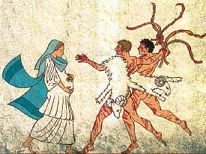The Real Meaning of Valentine’s Day
(By Crystal Holmes)
Cards, candies, roses, chocolate, candle-lit dinners, hearts… Every year millions of people exchange cards and give gifts to their beloved. But are these traditions the Christian should observe? Since God is love (1 John 4:16), many will say that this holiday not only reminds us of our love for our spouse, friends, and family, but also of God. But as a follower of God, you are commanded to “try the spirits whether they are of God” (1 John 4:1), and this holiday is not of God!
The name of the holiday, St. Valentine’s Day, owes its name to Valentine, a saint of the early third century, who allegedly helped Christians escape harsh Roman prisons or helped young couples to elope. The legends vary, and the truth is that no one knows for certain which legend (if any) is accurate. Regardless, Valentine became one of the most popular saints in the Middle Ages, a time when “the tradition of courtly love flourished. By the 15th century, it had evolved into an occasion in which lovers expressed their love for each other by presenting flowers, offering confectionery, and sending greeting cards (known as “valentines”).” (Wikipedia. “Valentine’s Day.” Link)
But this saint’s day is celebrated on the same day as an ancient Roman holiday to honor Juno, Queen of the Roman Gods and Goddesses – Rome’s “Queen of Heaven.” This feast to Juno was celebrated on February 14, and on the next day the festival of Lupercalia began.
LUPERCALIA
Lupercalia was a fertility festival dedicated to the founders of Rome, Romulus and Remus, and to Faunus, the Roman god of agriculture. This festival was intended “to avert evil spirits and purify the city, releasing health and fertility. Lupercalia subsumed Februa, an earlier-origin spring cleansing ritual held on the same date, which gives the month of February (Februarius) its name”. (Wikipedia. “Lupercalia.” Link. See also Holiday Symbols and Customs, 4th ed. © Omnigraphics, Inc. 2009. Link)
Lupercus is the god of shepherds, and his priests wore goatskins. To begin the festival, the priests would sacrifice a goat and a dog, and Vestal Virgins prepared cakes to be offered. Then the priests cut thongs from the goat skin; these were called februa.
The females would line up along the path to receive lashes from these whips, which were supposed to ensure fertility in the coming year, as well as prevent sterility and ease the pains of childbirth. The priests would dress themselves in the skins of the sacrificed goats in imitation of their god Lupercus, so it seemed if it was Lupercus running through the streets striking (“blessing”) young women with the bloody strips of goat skin. (Holiday Symbols and Customs, 4th ed. © Omnigraphics, Inc. 2009. Link)
It is said that some women would even bare their nakedness to the februa in hopes of obtaining better results. (Moore, Terry. “The Truth About Valentine’s Day.” 2006. p. 5.)
“To begin the festival, members of the Luperci, an order of Roman priests, would gather at a sacred cave where the infants Romulus and Remus, the founders of Rome, were believed to have been cared for by a she-wolf or lupa. The priests would sacrifice a goat, for fertility, and a dog, for purification. They would then strip the goat’s hide into strips, dip them into the sacrificial blood and take to the streets, gently slapping both women and crop fields with the goat hide. Far from being fearful, Roman women welcomed the touch of the hides because it was believed to make them more fertile in the coming year. Later in the day, according to legend, all the young women in the city would place their names in a big urn. The city’s bachelors would each choose a name and become paired for the year with his chosen woman. These matches often ended in marriage.” (Anonymous. “Valentine’s Day.” Link)
H. J. Rose adds, “[the priests transformed themselves] into human he-goats, the very embodiments of sexual vigour and at the same time of pugnacity. It is not by accident that the ancients supposed the performance to take place in honour of a god who might be identified with the Greek Pan, for he too is a he-goat, partly humanised”. (Rose, H. J. Religion in Greece and Rome. 1959. p. 206.)
Goats were used because of the symbol of sexual vigor, and Lupercus was also considered a god of shepherds. A dog was used because it was considered to be the flock’s main defender against the wolves. These priests dressed as goats, which were symbols of sexual fertility, but it is God who grants offspring to both man and beast, and it is God who gives rain for the crops of the field (Deuteronomy 11:16-17). Goats are also a symbol of pugnacity – of rebellion. And goats are represented in scripture as being disobedient to God and will “go away to everlasting punishment” (Matthew 25:32-46).
FEBRUA AND FEBRUARY
Februalia was the Roman festival of purification which occurred from February 13-15, and was later incorporated into the Lupercalia celebration. “The festival, which is basically one of Spring washing or cleaning (associated also with the raininess of this time of year) is old, and possibly of Sabine origin. According to Ovid, Februare as a Latin word which refers to means of purification (particularly with washing or water) derives from an earlier Etruscan word referring to purging.” (Wikipedia. “Februa.” Link)
According to Dr. Leo Ruickbie, author and historian on the occult: “February is named after the ancient Roman purification festival of Februa and is a time to honour the ancestors and orgiastically invoke the powers of fertility…. Although February is named after the ancient Roman purification festival of Februa, February is also a month sacred to the gods Mars (as Quirinus, or Romulus) and Juno, the wife of Jupiter”. (Ruickbie, Dr. Leo. “February: Imbolc to Terminalia.” Link)
Dr. Ruickbie goes on to talk about modern-day Valentine’s Day cards. Many cards today are given anonymously, which conveys the sender’s desire but not his identity. “The message that accompanies such cards is most often in the imperative, Be My Valentine, Be My Love, and so on. The structure of this exchange is remarkably similar to many magical formulae”. (ibid.)
Tell me, do you think God would be happy with someone who “orgiastically invokes the powers of fertility” and uses magical formulae to obtain a partner??
THE CONNECTION AND CHANGE
Some people claim that there is no connection between the Roman festival of Lupercalia and the modern holiday of St. Valentine’s Day. But there is one striking (pun intended) connection.
There is a common feature in the pictures above. Can you identify it? It is the ribbon. Nearly every box of candy at this time of year is secured by a red ribbon. Roses and images of Cupid also have red ribbons. Red, of course, to symbolize love and passion. But what else does the color red symbolize? “Red is the color most commonly associated with love…. It the symbolic color of the heart and the red rose, is closely associated with romantic love or courtly love and Saint Valentine’s Day. Both the Greeks and the Hebrews considered red a symbol of love as well as sacrifice.” (Wikipedia. “Red.” Link)
So why are there red ribbons on today’s valentines? Why does the red color signify love? Because it originally signified sacrifices, which were intended by pagan religions to insure fertility!
Now, let’s think. In the Lupercalia, they had a “lover’s lottery,” the equivalent of modern-day Valentine’s cards. No mention is made of heart-shaped boxes of candy or flowers being given, but is there anything in the ancient Lupercalia celebration that could represent those red ribbons? Well, as a matter of fact, there is.
 Those strips of goat skins used by the priests during Lupercalia were dipped in blood, and would, of course, be red from the sacrifice. Thus the red blood of the sacrifice for fertility has become the symbol of love; the bloody strips of goat flesh of the fertility rite have become the red ribbons which secure present-day Valentine’s Day gifts.
Those strips of goat skins used by the priests during Lupercalia were dipped in blood, and would, of course, be red from the sacrifice. Thus the red blood of the sacrifice for fertility has become the symbol of love; the bloody strips of goat flesh of the fertility rite have become the red ribbons which secure present-day Valentine’s Day gifts.
The truth is, Valentine’s Day is not so much about love and passion as it is about blood and sacrifice to a fertility god!
The Roman Catholic Church has always adopted the customs of paganism, often changing only the name to “baptize” it into “Christianity.” And they did this with Lupercalia, too. They changed the name to honor a “saint” and eventually did away with the sacrifice, but the lover’s lottery still remains. Their attempt to whitewash this idolatrous practice began in the 4th century. Emperor Constantine had just made Christianity the official religion of the Roman Empire. “As far back as 496, Pope Gelasius changed Lupercalia on Feb. 15 to St. Valentine’s Day on Feb. 14”. (Dobler, Lavinia. Customs and Holidays Around the World. 1962. p. 172.) “During this time a supposed saint named Valentine was chosen as the patron saint of lovers. Soon afterwards the church instituted a lottery of saints to be observed and they also created a new feast – the Purification of the Virgin Mary”. (Moore, Terry. “The Truth About Valentine’s Day.” 2006. p. 5.)
So instead of honoring Lupercus, now they honored a supposed Catholic saint. Instead of it being a festival to Juno, queen of the Greek gods, it became a festival of the Catholic idea of Mary. Instead of a lottery of lovers, it became a lottery of saints. But is this REALLY a different festival than the ancient Roman one was? Has renaming the key characters changed the origin and significance of the day the slightest bit?
The truth of the matter is, this festival was always a pagan fertility festival, as Dr. Ruickbie states, “February is the month of love magic and ancient Pagan sex rituals, so why is it named after a Christian saint?” (Anonymous. “Valentine’s Day Origin.” Link) Well, it is named after a Christian saint because the Roman Catholic Church did not want to repent of its evil. It did not want to stop keeping this ancient pagan festival. So it created a saint and a festival and activities, “baptizing” them into the Church, so that it could continue to keep the same old customs under new names. And the laymen, who were not privy to the “secrets” of the priests, were deceived into believing they were honoring God, when in fact they were serving the Devil!
*****
Now I want to examine the most widely used symbol of Valentine’s Day and Love in general – the heart symbol. Is it a Christian symbol? Should you display it even if you aren’t using it for Valentine’s Day traditions?
HEARTS
There are a few different theories for the origin of the heart symbol. The first is that the heart shape represents the buttocks of Aphrodite (see picture below). She was the goddess of beauty, and while she was considered to be beautiful all over, many of her worshippers thought that her buttocks were especially beautiful. The Greeks built a temple to Aphrodite Kallipygos, which literally means “goddess with beautiful buttocks.”
 The second theory is that the symbol represents the female pubic mound. “The Sumerian cuneiform is a character text that was widely used in Asia during the 3rd millennium B.C. and the symbol for “woman” in this text, known as “sal,” closely resembles the heart shape (below). Scholars believe that this cuneiform directly depicts the female pubic mound”. (Moore, Terry. “The Truth About Valentine’s Day.” 2006. p. 17.)
The second theory is that the symbol represents the female pubic mound. “The Sumerian cuneiform is a character text that was widely used in Asia during the 3rd millennium B.C. and the symbol for “woman” in this text, known as “sal,” closely resembles the heart shape (below). Scholars believe that this cuneiform directly depicts the female pubic mound”. (Moore, Terry. “The Truth About Valentine’s Day.” 2006. p. 17.)
Cuneiform was always written in angular shapes, so this was the best possible representation of the same ancient heart symbol. And it is quite probable that it grew out of the same ancient symbol representing Aphrodite’s buttocks.
 Sumerian symbol for woman. |
 Ishtar with Sumerian symbol for woman placed at the pubic mound. |
The heart shape could also “depict features of the human female body, such as the female’s buttocks, pubic mound, or spread vulva”. (Wikipedia. “Heart (symbol).” Link) Wikipedia goes on to say that this idea came from Pompeii, where people “conveyed their business via heart-shaped symbols depicting female breasts and sexual organ…. Since few wanted to declare the true meaning of the tattoo it was usually explained as a symbol of love”. (ibid.)
One common representation of the heart is with an arrow piercing the heart. Now, if the heart is really the female pubic mound, buttocks, or spread vulva, what would the arrow represent? So you see, at its core, the heart really is a symbol of sex and fertility. Is this really something you would want your little girl wearing?



